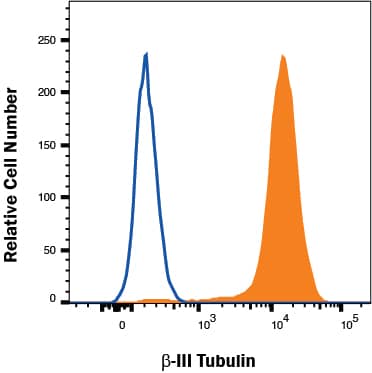Mouse Hip Antibody Summary
Lys24-Arg678 (Asn29Ser)
Accession # Q7TN16
Customers also Viewed
Applications
Please Note: Optimal dilutions should be determined by each laboratory for each application. General Protocols are available in the Technical Information section on our website.
Preparation and Storage
- 12 months from date of receipt, -20 to -70 °C as supplied.
- 1 month, 2 to 8 °C under sterile conditions after reconstitution.
- 6 months, -20 to -70 °C under sterile conditions after reconstitution.
Background: Hip
Hedgehog signaling proteins act as mitogens, morphogens, or inducing factors in many different cell types during embryonic development. They aid in growth, patterning, and morphogenesis in both vertebrates and insects (1). Hip (Hedgehog-interacting protein) is a type I transmembrane protein identified for its ability to bind biologically active Sonic Hedgehog. It is comprised of 700 aa, and includes a hydrophobic signal sequence, two EGF-like domains near the C-terminus, and a 22 amino acid membrane-spanning region at the C-terminal end (2). Hip has only been identified in vertebrates and binds all three mammalian Hedgehogs: sonic (Shh), desert (Dhh), and Indian (Ihh). Like the Hedgehog receptor Patched, Hip is a transcriptional target of Hedgehog signaling (2). Unlike Patched, Hip’s ability to bind hedgehogs is not involved in transducing a signal intracellularly, rather it regulates the availability of Hedgehog ligand extracellularly (3). Transgenic mice overexpressing Hip in proliferating chondrocytes display skeletal defects similar to those observed in Ihh mutant mice. These results indicate that Hip is involved in attenuating Hedgehog signaling (2). The expression pattern of Hip correlates with its ability to interact with all three mammalian Hedgehogs. It is expressed in a variety of organs, adjacent with sites of hedgehog expression. For instance, Shh is expressed in the epithelium of the lung, and Hip is found in the underlying lung mesenchyme (2). In fact, Hip knock-out mice exhibit neonatal lethality with respiratory failure due to defective branching morphogenesis. This phenotype correlates with altered expression of Shh markers suggesting an increase in Shh signaling (3). Interestingly, other developmental mechanisms that rely on normal Shh signaling, such as dorsal-ventral patterning of the neural tube, development of the somites, and organ laterality appeared histologically normal in Hip-/- mice (3). Mouse and human Hip share 94% amino acid identity through the entire protein sequence (4). R&D Systems’ recombinant Hedgehog-interacting protein is a potent antagonist of Shh signaling in vitro.
- Ingham, P.W. and A.P. McMahon (2001) Genes & Dev 15:3059.
- Chuang, P-T. and A.P. McMahon (1999) Nature 397: 17.
- Chuang, P-T. et al. (2003) Genes & Dev. 17:342.
- Bak, M. et al. (2001) Cytogenet. Cell Genet. 92:300.
Product Datasheets
Citations for Mouse Hip Antibody
R&D Systems personnel manually curate a database that contains references using R&D Systems products. The data collected includes not only links to publications in PubMed, but also provides information about sample types, species, and experimental conditions.
6
Citations: Showing 1 - 6
Filter your results:
Filter by:
-
Unique lingual expression of the Hedgehog pathway antagonist Hedgehog-interacting protein in filiform papillae during homeostasis and ectopic expression in fungiform papillae during Hedgehog signaling inhibition
Authors: Kumari A, Li L, Ermilov AN et al.
Developmental dynamics : an official publication of the American Association of Anatomists
-
Podocalyxin promotes the formation of compact and chemoresistant cancer spheroids in high grade serous carcinoma
Authors: Le Tran, N;Wang, Y;Bilandzic, M;Stephens, A;Nie, G;
Scientific reports
Species: Human
Sample Types: Cell Lysates, Spheroid
Applications: Immunohistochemistry, Western Blot -
Distinct effects of ligand-induced PDGFRalpha and PDGFRbeta signaling in the human rhabdomyosarcoma tumor cell and stroma cell compartments.
Authors: Ehnman M, Missiaglia E, Folestad E, Selfe J, Strell C, Thway K, Brodin B, Pietras K, Shipley J, Ostman A, Eriksson U
Cancer Res, 2013-01-21;73(7):2139-49.
Species: Human
Sample Types: Whole Tissue
Applications: IHC -
Down-regulation of hedgehog-interacting protein through genetic and epigenetic alterations in human hepatocellular carcinoma.
Authors: Tada M, Kanai F, Tanaka Y, Tateishi K, Ohta M, Asaoka Y, Seto M, Muroyama R, Fukai K, Imazeki F, Kawabe T, Yokosuka O, Omata M
Clin. Cancer Res., 2008-06-15;14(12):3768-76.
Species: Human
Sample Types: Cell Lysates
Applications: Western Blot -
Phorbol esters inhibit the Hedgehog signalling pathway downstream of Suppressor of Fused, but upstream of Gli.
Authors: Lauth M, Bergstrom A, Toftgard R
Oncogene, 2007-02-19;26(35):5163-8.
Species: Mouse
Sample Types: Cell Lysates
Applications: Western Blot -
Activation of the hedgehog pathway in a subset of lung cancers.
Authors: Chi S, Huang S, Li C, Zhang X, He N, Bhutani MS, Jones D, Castro CY, Logrono R, Haque A, Zwischenberger J, Tyring SK, Zhang H, Xie J
Cancer Lett., 2006-01-30;244(1):53-60.
Species: Human
Sample Types: Whole Tissue
Applications: IHC-P
FAQs
No product specific FAQs exist for this product, however you may
View all Antibody FAQsIsotype Controls
Reconstitution Buffers
Secondary Antibodies
Reviews for Mouse Hip Antibody
There are currently no reviews for this product. Be the first to review Mouse Hip Antibody and earn rewards!
Have you used Mouse Hip Antibody?
Submit a review and receive an Amazon gift card.
$25/€18/£15/$25CAN/¥75 Yuan/¥2500 Yen for a review with an image
$10/€7/£6/$10 CAD/¥70 Yuan/¥1110 Yen for a review without an image


















